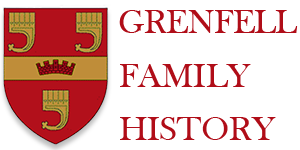Capt. Hubert Henry Grenfell RN (1845 - 1906)
GRENFELL, HUBERT HENRY (1845-1906), expert in naval gunnery, born at Rugby on 12 June 1845 was son of Algernon Grenfell, a clerk, by his wife Maria Guerin Price.
Joining the navy as a cadet on 13 Dec 1859, when fourteen, Grenfell passed out first from the Britannia, and gained as sub-lieutenant the Beaumont Testimonial. He qualified as gunnery lieutenant in 1867, and was appointed first lieutenant on H.M.S. Excellent on 22 Sept. 1869. While holding this appointment he worked out with Naval Engineer Newman what are claimed to have been the first designs of hydraulic mountings for heavy naval ordnance. He also engaged in literary work of a technical character, contributing to ‘Engineering’ and service journals. On 31 Dec. 1876 he was made commander, and on 1 May 1877 was appointed, on account of his linguistic attainments, second naval attache to the maritime courts of Europe. He also acted as naval adviser to the British representatives at the Berlin Congress of 1879. On 22 Sept. 1882 the sloop Phoenix, under his command, foundered off Prince Edward Island. No lives, however, were lost. Grenfell retired with the rank of captain on 2 Dec. 1887.
Grenfell was afterwards for many years associated with the experimental work of Armstrong, Whitworth & Co. He was the first to direct the Admiralty’s attention to the night-sighting of guns; and about 1891, on the introduction of the incandescent electric lamp, he invented his ‘self-illuminating night sights for naval ordnance.’ The invention was for fifteen years attached to all heavy guns in the British navy, and was adopted by some foreign navies. Grenfell was also one of the first to suggest the use of sight-scales marked in large plain figures for naval guns, and advocated, though without success, the adoption of a telescopic light for day use. He also worked out the arrangement subsequently adopted for quick-firing field artillery, by which the changes of angle between the line of sight and the axis of the bore which are required when firing at a moving target can be effected without altering the 1ine of sight.
In April 1877 Grenfell read before the Institution of Naval Architects an able paper advocating the trial, of Grusson’s chilled cast-iron armour in England, and in 1887 he published ‘Grusson’s Chilled Cast-Iron Armour’ (translated from the German of Julius von Schutz). He helped to form the Navy League, and served at one time on its executive committee. He died at Alverstoke, Hampshire, on 13 Sept. 1906.
[The Times, 26 Sept. 1906; Engineering, 28 Sept. 1906; Capt. H. Garbett, Naval Gunnery, 1897 ; C. Orde Brown, Armour and its Attacks by Artillery, 1893; Clowes, History of the Royal Navy, vol. 7, 1903 ; the Navy List, Jan. 1888.]
S.E.F.
Text reproduced from the Dictionary of National Biography 1901 – 1911 Vol. 1, by permission of Oxford University Press.

